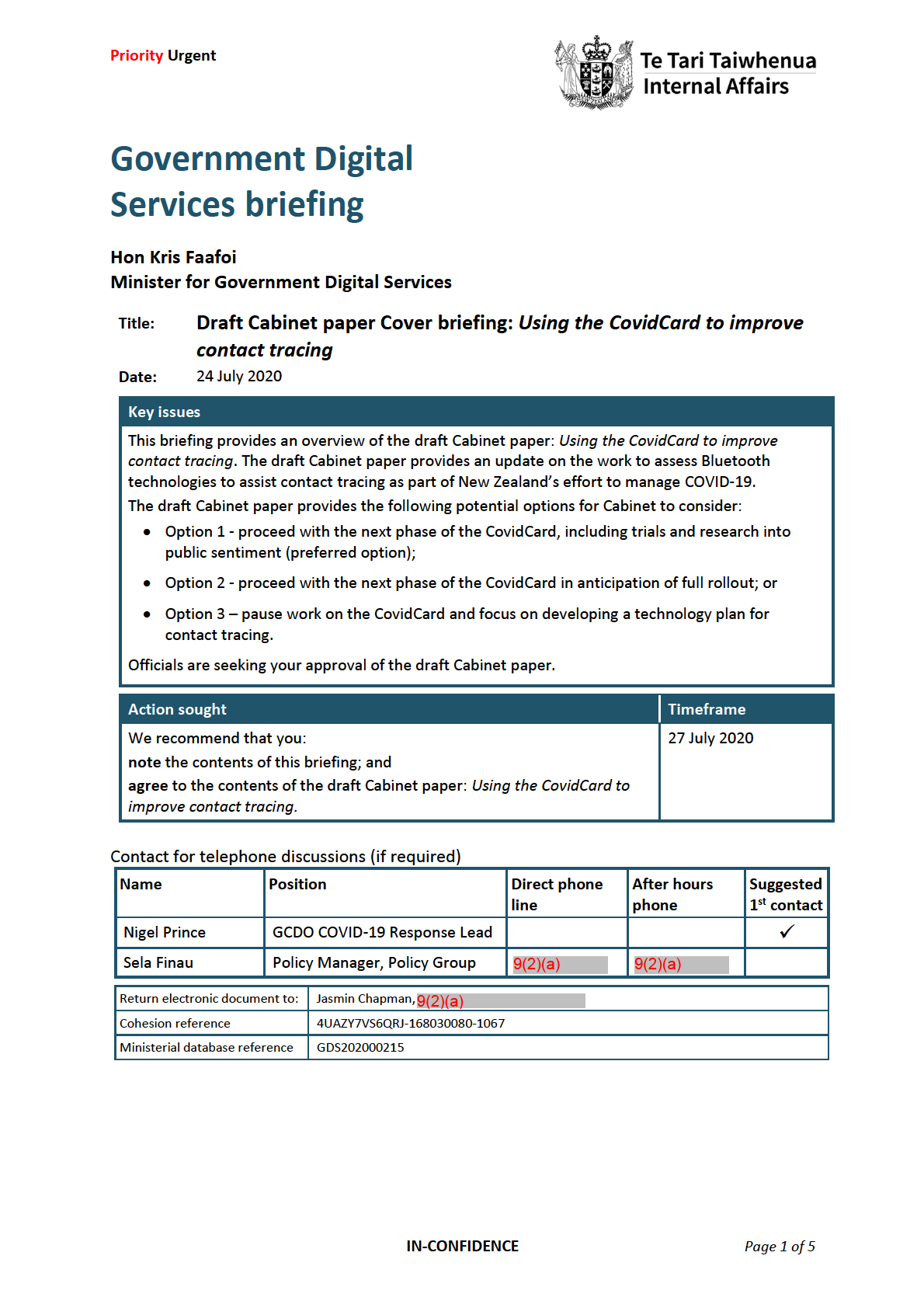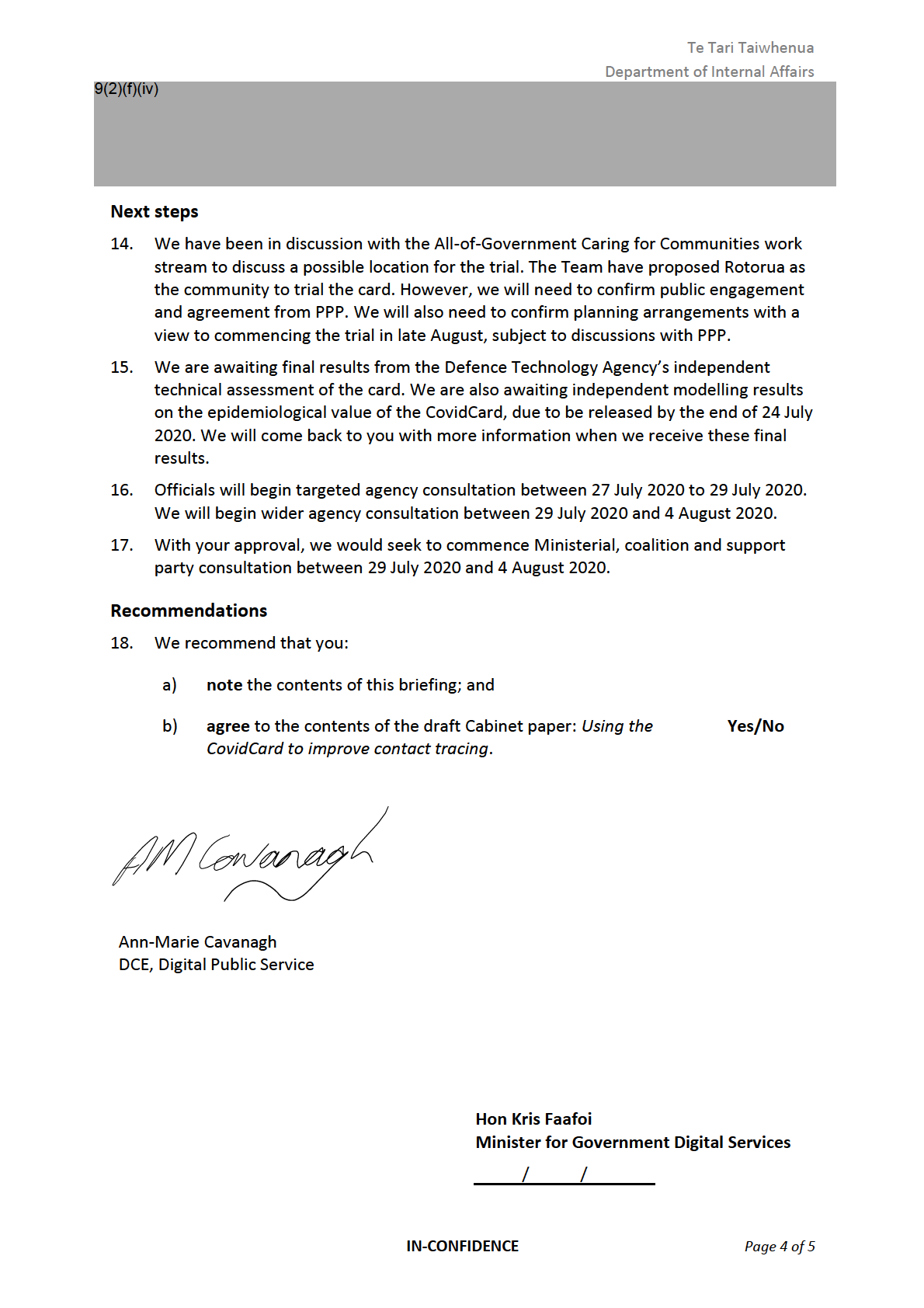
Te Tari Taiwhenua
Department of Internal Affairs
Purpose
1.
This briefing provides an overview of the draft Cabinet paper:
Using the CovidCard to
improve contact tracing, attached as
Appendix A (the Cabinet paper).
Background
2.
Effective contact tracing is a critical component of the strategy to isolate COVID-19 in
New Zealand, by identifying close contacts, isolating them quickly, and stopping the
spread of the virus. Digital technology can complement manual contact tracing by
speeding up the process, filling in memory gaps and recording contact with strangers.
It could also allow contact tracers to access contact information more rapidly which
can improve the chances of identifying and isolating potential cases of COVID-19
quickly.
3.
On 20 April 2020, Cabinet noted that officials are assessing a Bluetooth-enabled card
to support contact tracing and will report back to the Minister of Finance, the Minister
of Internal Affairs, the Minister of Health and the Minister for Government Digital
Services [CAB-20-MIN-0175 refers]. On 13 May 2020, the Minister of Justice was added
to this group and the Cabinet Social Wellbeing Committee noted that a report-back to
Cabinet on the consumer application Bluetooth assessment, and the Bluetooth-
enabled card, was scheduled for June 2020 [SWC-20-MIN-0043 refers].
4.
The Cabinet paper seeks Cabinet agreement to either:
4.1
proceed with the next phase of the CovidCard, including trials and research
into public sentiment (preferred option); or
4.2
proceed with the next phase of the CovidCard in anticipation of full rollout; or
4.3
pause work on the CovidCard and focus on developing a technology plan for
contact tracing.
Further assessments have shown that the CovidCard works technically
5.
Following the issuance of the PPP’s report, the Government Chief Digital Officer
(GCDO) led cross-agency work to independently assess the CovidCard and the benefits
of the CovidCard for contact tracing. Results from these assessments are promising but
there are issues that require further investigation, including the CovidCard’s security
and the extent of false positives (when someone is incorrectly classified as a close
contact).
6.
Independent modelling of the epidemiological value of the CovidCard has been
completed. However, the findings are due to be released by the end of 24 July 2020 so
have not yet been incorporated into the Cabinet paper.
7.
Officials have considered different deployment options for the CovidCard ranging from
a nationwide rollout and more targeted rollout. A nationwide rollout would have a
greater impact on the effectiveness at improving the current contact tracing system if
the CovidCard achieved greater uptake. However, a nationwide rollout would have
higher costs and greater implementation requirements.
Comment
8.
Digital technology can complement manual tracing by making it faster and more
accurate. However, it should be noted that countries around the world have been
attempting to use technology to improve contact tracing but one simple and effective
IN-CONFIDENCE
Page 2 of 5
Te Tari Taiwhenua
Department of Internal Affairs
solution has not been identified, and we continue to monitor international
developments.
9.
The NZ COVID Tracer app has had good initial uptake and adds to the accuracy of the
National Health Index data, yet its current limitations rely on people scanning QR
codes and it links to a location rather than contacts with people. 9(2)(f)(iv)
10. The assessment of the CovidCard demonstrates that it works from a technical
perspective, but it still requires further technical and security refinements to be
investigated through the trial process. The success of any technology solution requires
strategic policy decisions to address social licence and public uptake of the contact
tracing technologies.
11. The draft Cabinet paper outlines three options for you to consider:
11.1
Option 1- Proceed with the next phase of the CovidCard, including trials and
research into public sentiment (preferred option)
Under this option, officials would proceed with the next phase of work on the
CovidCard which would be expected to be completed by the end of October
2020. This would involve open and closed field trials, research to test public
sentiment to contact tracing technologies, and design work into the service
platform design. This option would not include work to prepare for nationwide
rollout of the CovidCard.
11.2
Option 2 – Proceed with the next phase of the CovidCard in anticipation of full
rollout
9(2)(f)(iv)
11.3
Option 3- Pause work on the CovidCard and focus on developing a technology
plan for contact tracing
9(2)(f)(iv)
12. The GCDO has worked with the PPP on the proof of concept for the CovidCard but new
arrangements are required would be needed for future work on technology to support
contact tracing. For option 1, it is important that work on design and preparation for
implementation to deploy and operate the card and associated systems is led by an
agency with strong digital capability. Additionally, the CovidCard would need to be
successfully integrated into the wider contact tracing system. We propose that the
Ministry of Health take the lead with support from the GCDO, PPP and other agencies.
This approach would help ensure any technology solution can be successfully
integrated into the wider contact tracing system. This position will need to be
confirmed with the Minister of Health.
IN-CONFIDENCE
Page 3 of 5

Te Tari Taiwhenua
Department of Internal Affairs
Appendix A: Draft Cabinet paper: Using the CovidCard to improve contact tracing
IN-CONFIDENCE
Page 5 of 5

